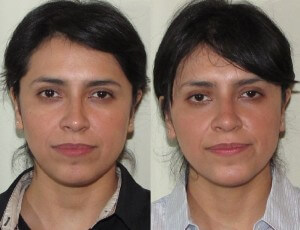An alar batten graft is a thin, oval-shaped graft, typically made of cartilage used to treat an external nasal valve collapse. Think of them as a fortress, strengthening the nasal airway and inhibiting valve collapse.
Alar batten comes from the words “alar” – referring to the area of the nose called the nasal ala and “batten” – a sailing term referring to a thin, bendable strip of wood placed in sails to provide support in bad weather (think: batten down the hatches). Thus, alar batten strips help support the nasal valves and prevent the nose from looking “pinched” on the sides of the nose.

The green oval seen in the diagram above represents an alar batten graft.
Where Are Alar Batten Grafts Placed?
Alar batten grafts are typically placed in pockets along the nasal sidewall, where there is a particular weakness. The sidewall refers to the area near the lower lateral cartilages, alar batten grafts can sometimes also be placed inferior to the lower lateral cartilage.
What Is The Goal Of Alar Batten Grafts?
The main goal of an alar batten grafts is to add support to a destabilized external nasal valve. A good way to tell whether your external nasal valve is weakened is if the tip of the nose appears “pinched” – although this test is not definite either way.
Alar batten grafts can transform an “overdone” rhinoplasty into a beautifully-contoured, aesthetically-improved nose. When little or no cartilage is left in the nose, the grafts act as a support system, preventing the collapse of the nasal ala and preventing alar retraction.

This before and after view of a patient shows the benefit of alar batten grafts.
What Are Alar Batten Grafts Made Of?
Alar batten grafts are made up of cartilage. Different doctors prefer different types of cartilage in constructing an alar batten graft. For example, a graft may be made up of cartilage from the nasal septum, rib or ear. Many doctors prefer ear cartilage, as ear concha cartilage is already curved and in the shape, you would want the ala to be after surgery.
Preparation For Alar Rim Grafting
Norelle Health individualizes every patient’s care. A minimum of half an hour is needed to fully understand your expectations and to get a complete history and evaluation of the inside and outside of your nose. Knowing what to expect will make the entire experience more pleasant and increase your satisfaction with the surgical results. The doctor will discuss the cosmetic and functional expectations of your alar batten grafts in detail to make sure all of your questions are answered. Depending on whether you have functional/breathing issues insurance may cover part of your surgery.
Alar Batten Grafts Surgery
Surgeons can insert alar batten grafts regardless of whether a rhinoplasty is an open or closed procedure. During the closed rhinoplasty surgery, your doctor makes an incision inside the nose along the inside of the nose, and a small pocket is created to fit the graft. Note that the size of the pocket must not be any bigger than the graft itself, so as to ensure stabilization and discourage later graft movement. During an open rhinoplasty, the batten graft is sutured directly to the area that needs additional strength. Both methods add structure and support to the lateral nasal sidewalls.

A frontal view of where alar batten grafts are placed inside the nasal interior.
Surgery Aftercare
The week after the procedure it is normal to have a mild headache for a day or two. You will be given some pain medicine, although most patients take only one or two doses and then switch to an over the counter pain medication. If you see scant, reddish fluid draining from the nose, you should place a dressing under the nostrils to avoid sniffling. You will probably feel a lot of congestion, although some people can breathe very well immediately after surgery. You may have bruising and swelling around the nose and eyes. This will start to resolve within a few days. Most swelling will go down after a couple of weeks, but changes in the nose can continue for a year or more. You will return to the office one week after surgery to have the nasal dressing removed, then return as needed to have the nose checked. Avoid strenuous exercise for three weeks. Avoid wearing glasses for six weeks.
Are Alar Batten Grafts Visible?
No, and yes. Alar batten grafts are sometimes visible as they are located under the skin of the sides of your nose. They are also lifting the nose outward so you will see the result of having the grafts in place. You also may be able to feel them, and they will feel very similar to the way the cartilage feels in the tip of your nose. For patient’s, this may be the trade-off needed to improve breathing.
Is It True That Alar Batten Grafts Will Make My Nose Look Wider?

Alar batten grafts provide structural support inside the nose. Take the above before and after photo as an example (actual patient).
Maybe. Although noses tend to look slightly swollen after the procedure, once the swelling and puffiness have subsided (usually ranging from 4-6 months), the nose generally will not be too much wider than it was before the surgery. The grafts, especially when made of septal cartilage or rib, can also sometimes be seen and felt through the skin. Graphs reverse the pinched look of an unsuccessful or overdone rhinoplasty and improve the function of the nose.